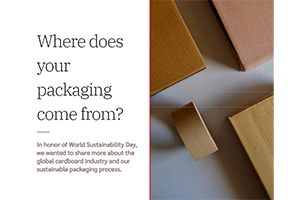
Did you know that there are 138,296 businesses in the state of Hawai’i?
Every single one of these businesses ships in raw materials. From napkins and take-out containers, to fabrics and computers, all materials not found or produced here in Hawai’i must be shipped or flown in.
And all of it comes in cardboard boxes.
Now, think about the 1.4 million residents in the state of Hawai’i, many of whom shop online. You browse Amazon for a new toaster, or perhaps a new iPhone case. It arrives on your doorstep in a cardboard box. You cut open the package, excitedly remove your item, and toss the box aside. In fact, as you read this, there’s a good chance you have cardboard nearby.
Have you ever stopped to ponder how all this cardboard got to you?
The journey starts in a forest. Depending on your location, this could be a forest in Europe, Asia, or the Americas. Some of the top paperboard producers in the world include China, the U.S., and Japan.
For cardboard that ends up in Hawai’i, Canada is likely the nearest source. In Canadian forests, various Spruce, Fir, and other softwood trees that have grown over decades are marked for harvest. They are chopped down, then transported to a pulp factory where they are debarked and chipped. The chips go through a long pulping process where the wood is cut, cleaned, heated, and flattened into thin paper layers.
These layers travel yet again to a box maker, who cuts and glues the boxes together. The boxes then make their way to wholesale packaging companies, and eventually end up in a brand’s warehouse. There, hundreds of items are placed in hundreds of boxes, which are then shipped to final destinations around the country. Every step of the way, tons of fossil fuels are consumed to power machines and transportation. The result? A lot of carbon emissions.
Now, here you may be asking:
Can’t you recycle these boxes? Doesn’t that help?
Well, here in Hawai’i, here’s what that process looks like. You deconstruct your cardboard boxes and place them in the blue recycling bin outside your house. They are picked up by the recycling truck on “Blue Bin Day”, and taken to the local county transfer station. The unfortunate reality is that because we have no recycling capabilities in the islands, the boxes are either burned in an incinerator (O'ahu) or shipped overseas to Taiwan, China, California, Malaysia, or even Saudi Arabia, where even then, it is not clear if they are actually recycled. (More and more restrictions are being placed on imports of recyclables due to capacity issues).
Cue additional tons of carbon emissions.
In 2018 alone, 65,000 tons of paper materials and 5,100 tons of plastics were shipped offshore from Hawai’i to “be recycled,” and private import/export research U.S. Trade News estimates that Honolulu’s largest export by tonnage in 2020-2021 was paperboard scrap.
It’s clear that in order to truly reduce our environmental impact,
the more we can reuse rather than recycle, the better.
As a proud producer of clean non-toxic nail products that do no damage to the land, sea, or air, we have always placed environmental sustainability at the core of our work - and this mantra extends to our packaging. From the very beginning, we wanted our packaging process to be as environmentally friendly as possible. We substitute glass for plastic and we avoid purchasing any packaging material outside Hawai’i beyond what is absolutely necessary.
And those cardboard boxes our raw materials come in?
We repurpose and reuse them!
Circle Pack HI also partners with local community organizations to facilitate regenerative uses of repurposed cardboard. Beyond being used as sustainable packaging material, cardboard can become an integral tool in farming - the cardboard can be mixed with worms to decompose into mulch or soil, used alone as physical support for farm and garden structures, or even mixed with diatomaceous earth to become effective chicken bedding.
Every month, Circle Pack HI hosts “Community Shredding Days” at Ma’ona Community Garden and Hilo Food Hub, where anyone in the community is welcomed to drop off their cardboard boxes and/or help shred it, turning it into a valuable, sustainable resource for community gardens, farms, and businesses.
We know tackling climate change can seem impossibly overwhelming, but we believe (and have seen firsthand) that tackling it step-by-step and doing our part can make a huge difference. In the same way we aim to help everyone have gorgeous nails without compromising their health or the environment, one nail-polish-lover at a time; we also aim to create a more sustainable world, one repurposed cardboard box at a time.
We hope you enjoyed learning more about our sustainable packaging process and we encourage you to see how all the businesses you support strive to reduce their environmental impact. We believe everyone deserves to know where their products come from - even their packaging! - because when we all have more consciousness as consumers, we are able to demand more accountability. If you have any questions, comments, or suggestions, please do not hesitate to reach out to aloha@kapanui.com.
by Colby Sameshima


